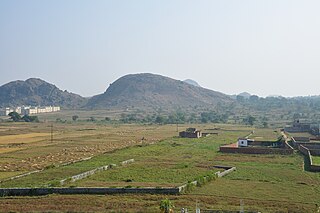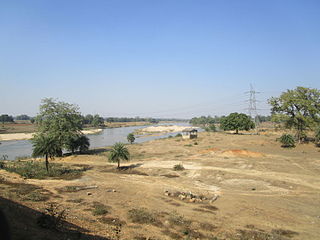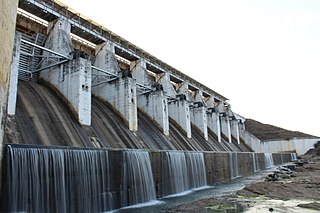Related Research Articles

The Chota Nagpur Plateau is a plateau in eastern India, which covers much of Jharkhand state as well as adjacent parts of Chhattisgarh, Odisha, West Bengal and Bihar. The Indo-Gangetic plain lies to the north and east of the plateau, and the basin of the Mahanadi river lies to the south. The total area of the Chota Nagpur Plateau is approximately 65,000 square kilometres (25,000 sq mi).

Damodar River is a river flowing across the Indian states of Jharkhand and West Bengal. The valley is rich in mineral resources and is home to large-scale mining and industrial activity. It was also known as the Sorrow of Bengal because of its ravaging floods in the plains of West Bengal. The construction of several dams on the Damodar and its tributaries has helped control some of the flooding.
Phusro is a nagar parishad in the Bermo subdivision of the Bokaro district in the Indian state of Jharkhand. It is situated about 35 kilometres (22 mi) from the district headquarters of Bokaro district. Damodar River passes through it.
Tenudam-cum-Kathara is a census town in the Gomia CD block in the Bermo subdivision of the Bokaro district in the Indian state of Jharkhand.

Damodar Valley Corporation (DVC) is a government-owned power generator which operates in the Damodar River area of West Bengal and Jharkhand states of India to handle the Damodar Valley Project, the first multipurpose river valley project of independent India. Indian Astrophysicist Meghnad Saha, the former chief architect of river planning in India, prepared the original plan for the Damodar Valley Project. The statutory corporation operates both thermal power stations and hydel power stations under the ownership of Ministry of Power, Government of India. DVC is headquartered in the Kolkata city of West Bengal, India.
Bokaro Thermal is a census town in Bermo CD block in the Bermo subdivision of the Bokaro district in the state of Jharkhand, India. Often colloquially referred to as 'BTPS', as the Bokaro Thermal Power Station is located in this area.

The Barakar River is the main tributary of the Damodar River in eastern India. Originating near Padma in Hazaribagh district of Jharkhand it flows for 225 kilometres (140 mi) across the northern part of the Chota Nagpur Plateau, mostly in a west to east direction, before joining the Damodar near Dishergarh in Asansol, Bardhaman district of West Bengal. It has a catchment area of 6,159 square kilometres (2,378 sq mi). The main tributaries, Barsoti and Usri, flow in from the south and north respectively. Apart from the two main tributaries some fifteen medium or small streams join it.

The Maithon Dam is located at Maithon, 48 km from Dhanbad, in the state of Jharkhand India. It is 15,712 ft (4,789 m) long and 165 ft (50 m) high.

Panchet Dam was the last of the four multi-purpose dams included in the first phase of the Damodar Valley Corporation (DVC). It was constructed across the Damodar River at Panchet in Dhanbad district in the Indian state of Jharkhand, and opened in 1959.
Gomia is a census town in the Gomia CD block in the Bermo subdivision of the Bokaro district in the Indian state of Jharkhand. The modern name is a transformation of Gumia over the years. Though, today, it is still listed as Gumia by the South Eastern Railway (India).

Konar dam is the second of the four multi-purpose dams included in the first phase of the Damodar Valley Corporation. It was constructed across the Konar River, a tributary of the Damodar River in Hazaribagh district in the Indian state of Jharkhand and opened in 1955. The place has scenic beauty and has been developed as a recreational spot.
The Bokaro River flows through the Hazaribagh and Bokaro districts in the Indian state of Jharkhand.

Tenughat Dam is an earthfill dam with composite masonry cum concrete spillway across the Damodar River at Tenughat in Petarwar block of Bokaro district in the Indian state of Jharkhand.

Durgapur Barrage is built across the Damodar River at Durgapur in Paschim Bardhaman district and partly in Paschim Bardhaman district, in the Indian state of West Bengal. It was constructed by Damodar Valley Corporation mainly for the purpose of irrigation and also to supply water to Industrial township of Durgapur. The irrigation and canal system was transferred to the Government of West Bengal in 1964.
Tilaiya Dam was the first of the four multi-purpose dams included in the first phase of the Damodar Valley Corporation. It was constructed across the Barakar River, at Tilaiya in Koderma district in the Indian state of Jharkhand and opened in 1953.
Bokaro Thermal Power Station B is located at Bokaro district in Jharkhand, 44 km from the Bokaro Steel City and is about 55 km from Dhanbad city.. The nearest railway station is Bokaro Thermal. The power plant is one of the coal based power plants of DVC.
West Bokaro Coalfield is located mostly in Ramgarh district and partly in Hazaribagh district in the Indian state of Jharkhand.
Tenu is a census town in the Petarwar CD block in the Bermo subdivision of the Bokaro district in the Indian state of Jharkhand. It is located at the foot of Tenughat Dam, 42 km from Bokaro Steel City, the district headquarters,
Nawadih is a village in the Nawadih CD block in the Bermo subdivision of the Bokaro district in the Indian state of Jharkhand.
Bermo subdivision is an administrative subdivision of the Bokaro district in the North Chotanagpur division in the state of Jharkhand, India.
References
- ↑ "The Hazaribagh district" (PDF). Archived from the original (PDF) on 28 October 2014. Retrieved 29 April 2010.
- ↑ Lister, Edward (October 2009). Hazaribagh. BiblioBazaar. p. 9. ISBN 978-1-115-79277-6 . Retrieved 6 June 2012.
- ↑ "Konar Dam". india9.com. Retrieved 17 April 2010.
- ↑ "DVC". Konar. DVC. Archived from the original on 10 February 2007. Retrieved 17 April 2010.
- ↑ Hydrology and Water Resources of India By Sharad K. Jain, Pushpendra K. Agarwal, Vijay P. Singh. googlebooks. 16 May 2007. ISBN 9781402051807 . Retrieved 17 April 2010.
- ↑ "Integrated Flood Management" (PDF). Flood Management – Damodar River Basin. World Metereological Organisation. Retrieved 3 May 2010.